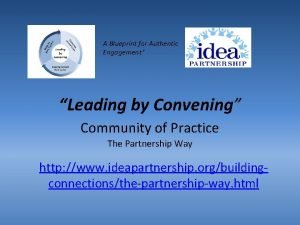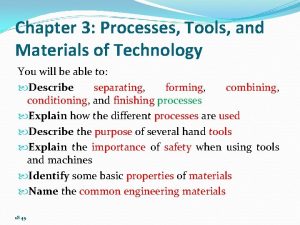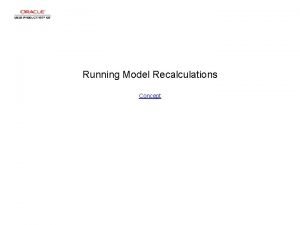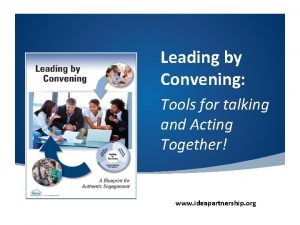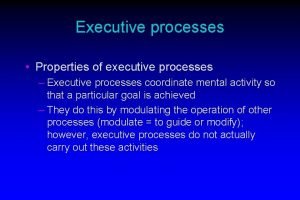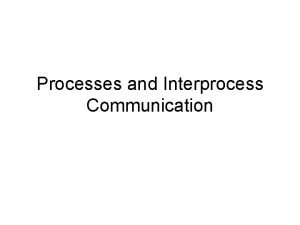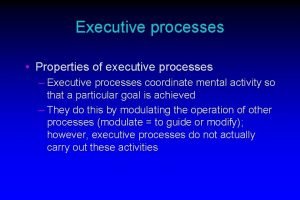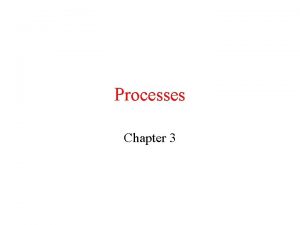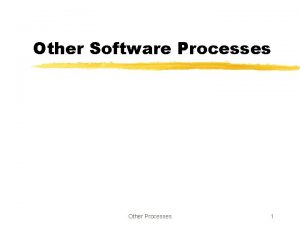Tools for running multistakeholder processes Convening a multistakeholder













- Slides: 13

Tools for running multistakeholder processes Convening a multi-stakeholder process Getting the appropriate stakeholders together and building a common roadmap

How much time & resources does it take to use this tool? 1. This tool is designed as a series of activities for planning an MSP. It will provide guidance to accompany an ongoing process of developing an MSP. This tool doesn’t give immediate “results” while you are using it! 2. There is no set time to use this tool. It can take just 3 -4 hours to go through the activities and make a plan. However, the MSP itself can be a multi-year process, as it will be part of an ongoing influencing strategy. 3. You can use this tool alone or with others in your team. 4. There is no need for particular resources. In some cases, An effective, viable business model can be the most effective you may want to commission specific research, but this won’t way of convincing the private sector to buy in to your idea be needed in most cases. Page 2

Stakeholder Map / Power Analysis • First, we need to understand who the relevant stakeholders are. • Use the Power Analysis tool to map the stakeholders and how they influence outcomes. • Make a note of each stakeholder’s objectives and strategies. • Make a note of where you see synergy between the stakeholders for the outcome you are trying to achieve. Page 3

Getting the right people involved • Based on the Power Analysis, select 20 -25 people to involve in the MSP. • These should be leading actors who can together achieve the desired outcome. To arrive at 20 -25 people, you will probably need a ‘long’ list of 3540 people to invite! (MSPs can include more people or fewer people, but 2025 is a good size for engaging diverse stakeholders. ) Make sure to involve people who “know everyone” – you know who they are! • In most cases, you will need to include someone from the government, at the right level/department as appropriate for your desired outcome. • If possible, have a multi-stakeholder “convening team” of 3 -5 people who are willing to play an active role in organising the MSP. • For example, this could be a private sector person, a government person, a donor person, and an Oxfam person. This will make all stakeholders more willing to participate openly, without feeling that this work is only Oxfam’s agenda. Page 4

Designing the first MSP meeting (1) • Organise a first meeting for the 20 -25 stakeholders who are leading actors and willing to engage. • Adapt the length of the meeting to your stakeholders and how much they already care about the issue. • For example, if the issue is fundamental to all stakeholders’ survival (e. g. extreme environmental degradation), then you can have a 3 -4 day event. However, usually, people are only willing to make time for 1 day. Private sector people will often only participate for 1 day or half-day. Set the length of the meeting so that everyone can participate throughout. • Have 1 to 1 conversations with each stakeholder before the first meeting. • This can be in person, by phone or by email, depending on what is possible. Use this conversation to understand how the issue affects each stakeholder, and what outcomes they would like to see. Use this information for designing the content of the meeting. Page 5

Designing the first MSP meeting (2) • Bring in an independent external facilitator. • This will make the stakeholders more comfortable than having an Oxfam facilitator. The facilitator should also be experienced in MSPs. You can work closely with the facilitator to design the event, based on stakeholders’ input and the below tips. • Focus on fostering collective learning. • This first meeting isn’t about getting things done. It is too early to expect this from diverse stakeholders! Focus the agenda on learning about the issue together. Don’t pressure stakeholders or yourself into outcomes yet. • Make it a deeply personal experience, not just rational discussion. • Purely rational discussions do not reach deep enough to bring together diverse stakeholders. The event should be designed to be emotionally, creatively and intellectually engaging for everyone. For example, you could visit the field together, interact directly with affected people, or bring in inspirational artists. • Ensure that less powerful stakeholders can participate fully. • With the facilitator’s help, ensure that the less powerful stakeholders are participating fully and comfortably. Ensure that they are heard! Otherwise the MSP will strengthen existing power imbalances. Page 6

Following up on the first MSP meeting • Have a full debrief with the facilitator and the convening team (if you have one). • Share insights on what the stakeholders were thinking, feeling and expressing. Include the informal reactions, e. g. during the tea break. If there were ideas on how to take the MSP forward, note these down. • Have 1 to 1 conversations with each stakeholder to get ideas on ways forward. • This can be in person, by phone or by email, depending on what is possible. Get feedback on what they learned from the first MSP meeting, and what they think the MSP should do going forward. • Share a report of the meeting with all stakeholders. • It is often best to share notes under the “Chatham House” rule. This means that comments are not attributed to particular people. Page 7

Roadmap for the MSP going forward (1) • Based on the feedback from the first meeting, you will need to propose how to take the MSP forward. • e. g. Community of practice • This will allow stakeholders to share experiences, learn and inspire each other to work better on this issue. If it is an urgent and challenging issue, 34 workshops across 4 -8 months may be a useful format. If the issue is ongoing and fairly well understood, a workshop every 6 months may be a useful format. Generally, this is a relatively easy MSP to manage. • e. g. Developing a new standard/certification • This will set a minimum standard or an aspirational standard for stakeholders to meet on this issue. This could be linked to a certification system. It will take at least 1 -2 workshops across 4 -8 months for a critical mass of stakeholders to agree to set a standard. Then, there will need to be another series of 4 -8 workshops across 1 -2 years to agree what the standard will be and how it will be enforced. Generally, this is a very heavy MSP to manage and will require setting up a formal independent organisation. Page 8

Roadmap for the MSP going forward (2) • e. g. Advocacy coalition • This will allow stakeholders to strongly communicate a common message on the issue, e. g. a public awareness campaign, or advocacy on government policy. 2 -3 workshops across 4 -8 months may be a useful format. Generally, this MSP is not a big challenge to organise administratively, but it can be a big challenge to agree common messages. Invest the first 1 -2 workshops on building a shared understanding of the issue, before launching into agreeing messages! • e. g. Developing joint programmes • • This will allow stakeholders to collaborate on joint programmes. This might be more effective for sub-groups of 3 -4 stakeholders, rather than the full group. The MSP can facilitate these connections for collaboration. 1 -2 workshops across 4 -8 months may be a useful format. Generally, this is a relatively easy MSP to manage. MSPs can have several of the above features, but it’s most manageable to start with one feature! Page 9

Setting the terms of an MSP (1) • The MSP should be run in a way that: • Earns the trust of all stakeholders • Keeps a healthy power balance between the stakeholders • Makes the MSP as efficient as possible. • Confidentiality • For every meeting, it should be clear whether the discussion is confidential or not. Often, a useful principle is the “Chatham House” rule – the discussion is not confidential, but it cannot be attributed to any particular person. Page 10

Setting the terms of an MSP (2) • Governance & decision-making • If the MSP needs formal organisation (e. g. for standard-setting), there will need to be a clear and transparent governance mechanism. It’s best to get expert advice for this, rather than trying to design this alone! Relevant questions are: Who will be the executive/secretariat? How are decisions made? How are the various stakeholders represented? However, if the MSP is fairly informal (e. g. community of practice), then it’s probably most efficient for you as the convenor to make decisions, while consulting other stakeholders. • Grievances • If the MSP has power over the stakeholders (e. g. control over funding), there should be a grievance mechanism. This should be accessible, transparent and run on an independent basis. • Financing • Ideally, try to have multi-stakeholder financing for a MSP, so that no single stakeholder has undue power. Page 11

Planning time & resources for an MSP • The time & resources needed depends on the type and scale of the MSP. • However, there are some minimum resource requirements: • For any MSP, a key ingredient is staff time. Budget at least 20%-50% of two people’s time for 3 -6 months in preparing, running and following up on the first MSP meeting. The staff time required for the remainder of the MSP will depend on the type and scale of the MSP. • The staff acting as convenor needs to be someone with good interpersonal skills, who is able to deal with conflict. • There needs to be budget for an experienced skilled facilitator for meetings. Page 12

Tips from Malawi on MSP experience (advocacy coalition) Map all the key stakeholders Engage the government (at the right levels, departments, and the right individuals) Use good practice tools and materials to understand power, stakeholders and gender issues Map/understand their objectives and strategies – and focus where there is synergy Regular power analysis – including party politics Know who the spoilers are and engage them Involve people who ‘know everyone’ Don’t start from scratch – build on existing fora, networks and initiatives Build deep trust – 1 to 1 and together as a group Meet with all key stakeholders 1 to 1 Know where funding comes from (donors) & new money for MSP Choosing the right messenger is as important as the message itself Make it a deep personal experience for all involved Budget staff time – because trust building is time consuming Message to advocacy staff – this is about consensus and working with people who don’t share all our views As a convenor Oxfam needs to judge when it is useful to be more or less visible in MSP Building a common vision and joint action – not as Oxfam but together Membership organisations need mentoring on how to engage constructively Tap into people’s deep values and energy, motivations This needs staff with great interpersonal skills who can connect with others Message to programme delivery staff – this is about going on a journey not delivering a set of activities There will be value judgements to be made about alliances and association, so to be aware of red lines Seek to get voices of those with less power to be heard and respected It’s never right first time – change, learn and adapt your approach week by week Be willing to talk about mistakes & failures We may need to team up with quite different partners, and to be clearer about different types of p’ship Page 13
 Once upon a time there lived a little
Once upon a time there lived a little Running running running
Running running running Leading by convening
Leading by convening Concurrent processes are processes that
Concurrent processes are processes that It is used to process materials by hand.
It is used to process materials by hand. Typiska drag för en novell
Typiska drag för en novell Trög för kemist
Trög för kemist Argument för teckenspråk som minoritetsspråk
Argument för teckenspråk som minoritetsspråk Humanitr
Humanitr För och nackdelar med firo
För och nackdelar med firo Toppslätskivling effekt
Toppslätskivling effekt Redogör för vad psykologi är
Redogör för vad psykologi är Geometri för barn
Geometri för barn Claes martinsson
Claes martinsson


